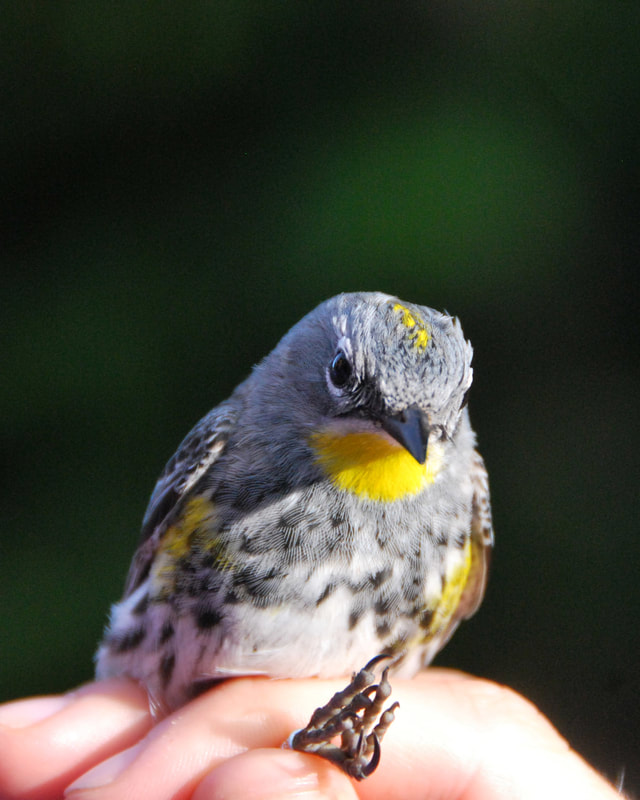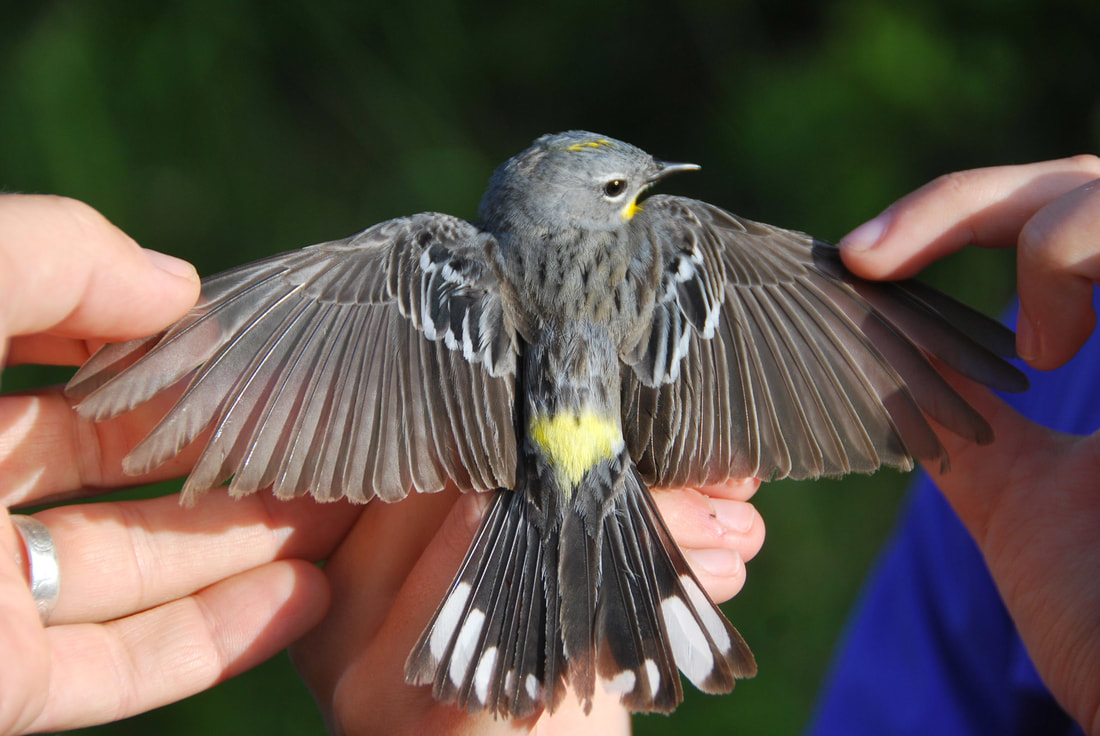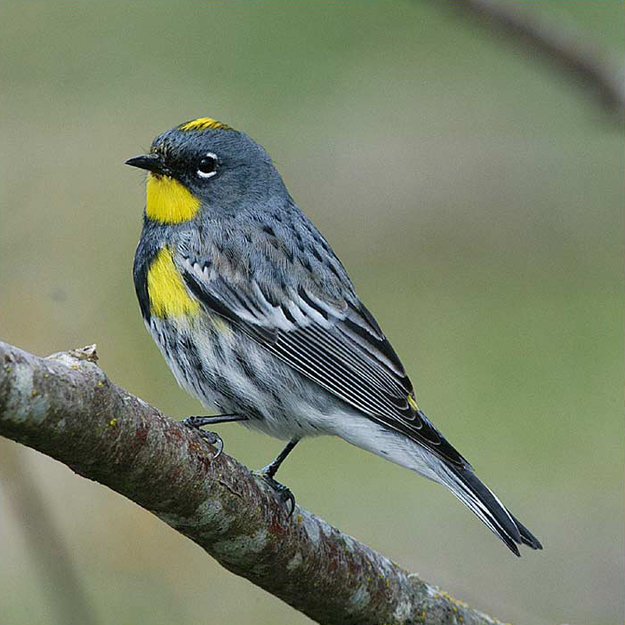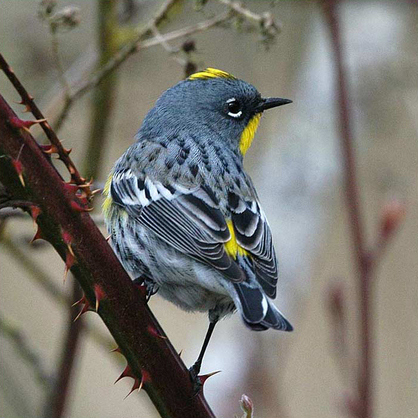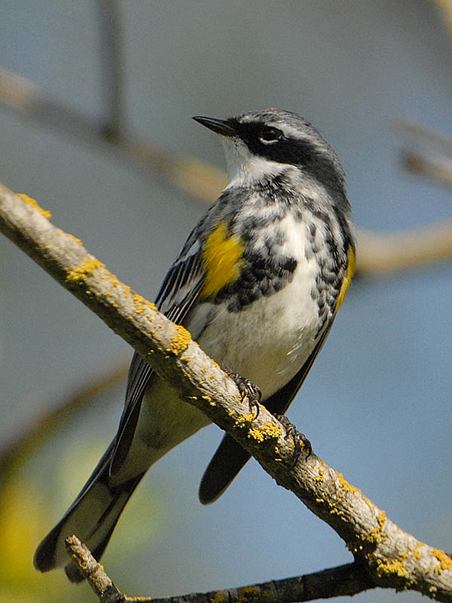Yellow-rumped warbler, Audubon's yellow-rumped warbler, Audubon's warbler • Setophaga coronata auduboni
Top: Female Audubon's yellow-rumped warblers in breeding plumage. This female found on Calvert Island is more brightly-coloured than usual, as females tend to have more subdued plumage than males. Photos by Eric Demers with the VIU Bird Banding Project. Bottom: male in breeding plumage. Photos by Mike Yip.
Identification
Audubon's yellow-rumped warbler, the western subspecies of the yellow-rumped warbler, can be identified by bright yellow patches on its rump, sides, crown, and throat. The rest of its colour is dark grey to black in summer and a duller brown in winter, both with white patches on the wings and tail. Breeding females may have some brown plumage, and the yellow-black contrast is sharper overall in males than females. The song is a warbling whistle.
Audubon's yellow-rumped warbler, the western subspecies of the yellow-rumped warbler, can be identified by bright yellow patches on its rump, sides, crown, and throat. The rest of its colour is dark grey to black in summer and a duller brown in winter, both with white patches on the wings and tail. Breeding females may have some brown plumage, and the yellow-black contrast is sharper overall in males than females. The song is a warbling whistle.
|
Habitat & Range
The yellow-rumped warbler inhabits forest edges and open coniferous forests during the summer breeding months. In winter it spends time in a variety of habitats including thickets, open woods, gardens, parks, and sometimes beaches. The Audubon subspecies, which is restricted to western North America, is found on the Central Coast during the summer breeding months. It is found north to southeastern Alaska and northern British Columbia in the summer; its winter breeding range extends as far south as Mexico and Central America. Click here for subspecies range maps. Find more information at the British Columbia Breeding Bird Atlas here. Similar Species The myrtle subspecies (Setophaga coronata coronata) migrates through the Central Coast and winters in part of southwestern BC. It can be distinguished from the Audubon subspecies by its white throat and white eyebrow. Note that the myrtle and Audubon subspecies used to be considered separate species, and recent research suggests that these may indeed be full species. Read more on this Audubon article. iNaturalist https://www.inaturalist.org/taxa/126562-Setophaga-coronata-auduboni |
The similar myrtle yellow-rumped warbler, which migrates through the Central Coast. Note the Audubon subspecies' yellow throat, and the myrtle subspecies' white throat and white eyebrow. Photos by Mike Yip.
|
References
Dunn, J. L. and Alderfer, J. (Eds.). (2011). National Geographic Field Guide to the Birds of North America. (6th Ed.). Washington, D.C.: National Geographic Society. Pp. 434-435; 554.
Kaufman, K. Yellow-rumped Warbler Setophaga coronata. Audubon Birds. National Audubon Society. Accessed 30/01/2015.
Yellow-rumped Warbler. The Birds of North America Online (A. Poole, Ed.). Ithaca: Cornell Lab of Ornithology. Retrieved from the Birds of North America Online. Accessed 30/01/2015.
Author and editor of page
Kelly Fretwell and Brian Starzomski (2015).
Dunn, J. L. and Alderfer, J. (Eds.). (2011). National Geographic Field Guide to the Birds of North America. (6th Ed.). Washington, D.C.: National Geographic Society. Pp. 434-435; 554.
Kaufman, K. Yellow-rumped Warbler Setophaga coronata. Audubon Birds. National Audubon Society. Accessed 30/01/2015.
Yellow-rumped Warbler. The Birds of North America Online (A. Poole, Ed.). Ithaca: Cornell Lab of Ornithology. Retrieved from the Birds of North America Online. Accessed 30/01/2015.
Author and editor of page
Kelly Fretwell and Brian Starzomski (2015).
